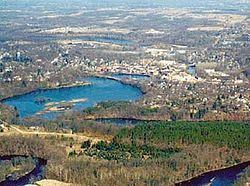CERCLIS ID MID006007306 | Listed 30 August 1990 Proposed 5 May 1989 | |
 | ||
Responsibleparties Georgia-Pacific Corporation, Millennium Holdings, LLC | ||
In 1990, the Allied Paper, Inc./Portage Creek/Kalamazoo River in southwestern Michigan was declared by the Environmental Protection Agency (EPA) to be a Superfund site – in other words, an abandoned industrial site containing significant amounts of toxic waste. The EPA and companies responsible for the waste in this area, which includes a three-mile section of Portage Creek as well as part of the Kalamazoo River, into which it flows, are currently involved in an effort to reduce the amount of toxic waste at the site, which is contaminated by PCBs (polychlorinated biphenyls) from paper mills and other factories.
Contents
History
After the Industrial Revolution, many paper mills that sprouted up along the Kalamazoo River were found to be the cause of PCB contamination.The publication in a 1953 issue of Life Magazine of a photograph depicting dead carp floating in the Kalamazoo River drew national attention to the public interest. The Kalamazoo Superfund site was added to the National Priorities List on August 30, 1990, and the First Cleanup Action began in late 1990. Between 1990 and 2000, under an agreement with the EPA and the State of Michigan, several of the current and past owners of plants that had been responsible for the contamination investigated the Portage Creek site. PCB Contamination
Polychlorinated biphenyls constitute a wide array of now-banned organic chemicals with a variety of industrial applications. At the Kalamazoo River site, most PCBs are a result of the recycling of carbonless copy paper during the 1970s, the waste products from which were dumped into the river. PCBs were produced from 1929 to 1979, when they were banned by the Toxic Substances Control Act.
Health Risks
PCBs are human carcinogens, and can also have a negative effect on the human immune, reproductive, and endocrine systems. PCBs in the Kalamazoo River adhere to the fatty tissue of fish, and over time a process of bioaccumulation takes place, meaning that the PBCs appear in increasing concentrations in organisms higher up on the food chain, including humans. A report by the Michigan Department of Health found that the Kalamazoo River is now safe for recreational use despite some PCB contamination.
Kalamazoo River
The Kalamazoo River makes up a large portion of the Kalamazoo River Watershed, which spans about 162 miles and feeds into Lake Michigan. The 80 miles of the Kalamazoo River and Portage Creek are officially divided into five sections known as Operable Units (OU): Allied Paper/ Bryant Mill Pond (1), Willow Boulevard and A-Site Landfill (2), King Highway Landfill (3), 12th Street Landfill (4), and the Portage Creek (5). Portage Creek is southwest of Kalamazoo, connecting to the Kalamazoo River near the King’s Highway Operable Unit. The Michigan Department of Environmental Quality (MDEQ) manages the Superfund site.
CERCLA/ Superfund
The Comprehensive Environmental Response, Compensation and Liability Act (CERCLA), which was passed in 1980, calls for the cleaning up, under EPA supervision, of abandoned hazardous waste sites that release pollutants into the environment. The EPA works at the Kalamazoo Superfund site in conjunction with state and regional interest groups.
NPL
The National Priorities List allows for highly hazardous sites to be dealt with immediately. Substances deemed toxic are given Hazard Ranking System Package scores based on the level of toxicity and the potential hazard to human health and the ecosystem. Sites with Hazard Ranking System Package scores of 28.5 or higher out of 100 are placed on the NPL, pending official approval.
PRP
The Potentially Responsible Party is an individual, corporation, or group that can be held financially responsible, at least in part, for the cleanup of the Superfund site. H. Millennium Holdings, Plainwell Inc., and Georgia-Pacific Corporation, the past and present owners of paper facilities that contributed to the PCB contamination, are now involved in the remediation, particularly covering the financial costs, and have also formed the Kalamazoo River Study Group (KRSG), which aids in the remediation of the site, particularly the Time Critical Removal Action.
Remediation
The cleanup of Kalamazoo River Superfund site started upstream and has moved downstream. First, extant PCB sources were removed, with particular concern being expressed about the continuing release of PCBs in the Bryant Mill Pond area, where a $7.5 million removal program was carried out from June 1998 to May 1999. Two of the Operable Units, King Highway Landfill and Allied Inc., had sheet pile and caps installed, a process which does not remove PCBs but serves as a protective layering containing them. Time Critical Removal Action was declared in spring 2007 at the Plainwell site, where the removal process included sediment removal and the reintroduction of native plants. Any waste containing over 50 ppm (parts per million) of PCB was disposed of in Bellville’s Environmental Quality Corporation Wayne Disposal Landfill. Most of the waste, however, had a lower PCB concentration and was disposed of at nearby landfills.
Portage Creek
Work on the last OU, Portage Creek, began in September 2011. From April to October 2012, the EPA removed about 12,000 cubic yards of PCB-contaminated soil and sediment from Portage Creek, replaced it with clean sediment, and planted new trees and other vegetation. The EPA planned to return to the site in March 2013 to “try to complete the last segment of Portage Creek, where the creek and the Kalamazoo River meet.” If necessary, the EPA planned additional work at Portage Creek in the summer of 2014.
